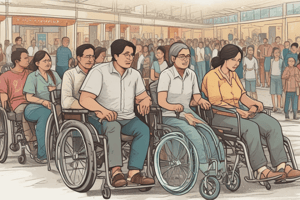Podcast
Questions and Answers
Which of the following reflects a primary goal of disability rights activists in building a sense of community?
Which of the following reflects a primary goal of disability rights activists in building a sense of community?
- Emphasizing the diverse range of individual experiences and perspectives within the community.
- Focusing on isolated incidents of discrimination to highlight the unique challenges faced by each individual.
- Promoting competition among individuals with disabilities to foster innovation and resilience.
- Highlighting shared experiences of inaccessibility and discrimination. (correct)
How did the return of soldiers from WWI/WWII influence the disability rights movement in Canada?
How did the return of soldiers from WWI/WWII influence the disability rights movement in Canada?
- It caused a shift away from community-based support towards institutional care for people with disabilities.
- It led to the establishment of government programs that fully addressed the needs of veterans and people with disabilities.
- It resulted in decreased public awareness of disability issues due to the focus on veterans' needs.
- It prompted the creation of non-profit organizations advocating for veterans and providing essential services. (correct)
What was the main objective of the deinstitutionalization movement regarding people with disabilities?
What was the main objective of the deinstitutionalization movement regarding people with disabilities?
- To prioritize institutional care over community-based support for individuals with disabilities.
- To integrate people with disabilities into mainstream society with equal access to community services. (correct)
- To segregate individuals with disabilities from mainstream society to provide specialized care.
- To limit access to services to encourage self-reliance among people with disabilities.
In the context of disability rights, what do barrier-free policies and legislation primarily aim to achieve?
In the context of disability rights, what do barrier-free policies and legislation primarily aim to achieve?
Which of the following scenarios exemplifies the principles of the deinstitutionalization movement?
Which of the following scenarios exemplifies the principles of the deinstitutionalization movement?
What was the main objective of establishing the Bureau on Rehabilitation in 1979?
What was the main objective of establishing the Bureau on Rehabilitation in 1979?
Which key principle is enshrined in Section 15 of the Canadian Charter of Rights and Freedoms?
Which key principle is enshrined in Section 15 of the Canadian Charter of Rights and Freedoms?
What is the primary goal of the Accessibility Canada Act passed in 2019?
What is the primary goal of the Accessibility Canada Act passed in 2019?
The AODA (Accessibility for Ontarians with Disabilities Act) has a target date of 2025 for full accessibility in Ontario. What does this entail?
The AODA (Accessibility for Ontarians with Disabilities Act) has a target date of 2025 for full accessibility in Ontario. What does this entail?
How does the Americans with Disabilities Act (ADA) ensure equal opportunities for individuals with disabilities?
How does the Americans with Disabilities Act (ADA) ensure equal opportunities for individuals with disabilities?
What is the main purpose of Section 504 of the Rehabilitation Act of 1973 in the United States?
What is the main purpose of Section 504 of the Rehabilitation Act of 1973 in the United States?
The Employment Equity Act of 1986 aims to promote workplace inclusion within federally regulated organizations. Which groups, besides people with disabilities, are also mentioned as equity-deserving?
The Employment Equity Act of 1986 aims to promote workplace inclusion within federally regulated organizations. Which groups, besides people with disabilities, are also mentioned as equity-deserving?
How does the Ontarians with Disabilities Act (ODA) differ from the Accessibility for Ontarians with Disabilities Act (AODA)?
How does the Ontarians with Disabilities Act (ODA) differ from the Accessibility for Ontarians with Disabilities Act (AODA)?
How does Section 504 primarily ensure the rights of students with disabilities in schools?
How does Section 504 primarily ensure the rights of students with disabilities in schools?
Which of the following best describes a key limitation of Section 504 compared to the Americans with Disabilities Act (ADA)?
Which of the following best describes a key limitation of Section 504 compared to the Americans with Disabilities Act (ADA)?
What was the main significance of Camp Jened, as depicted in 'Crip Camp'?
What was the main significance of Camp Jened, as depicted in 'Crip Camp'?
Which question encourages viewers to consider the representation and perspective in storytelling, as highlighted by the 'Crip Camp' pre-viewing questions?
Which question encourages viewers to consider the representation and perspective in storytelling, as highlighted by the 'Crip Camp' pre-viewing questions?
In the context of 'Crip Camp', how did the experience at the camp influence the future lives of some of the campers?
In the context of 'Crip Camp', how did the experience at the camp influence the future lives of some of the campers?
What critical reflection is prompted by asking 'What comes to your mind when you think of disability?' before watching 'Crip Camp'?
What critical reflection is prompted by asking 'What comes to your mind when you think of disability?' before watching 'Crip Camp'?
How does reflecting on the question, 'How is disability currently portrayed by the media?' connect to a broader understanding of disability rights?
How does reflecting on the question, 'How is disability currently portrayed by the media?' connect to a broader understanding of disability rights?
In what way does the question 'How do disability rights connect with other social issues and causes?' promote a deeper understanding of social justice?
In what way does the question 'How do disability rights connect with other social issues and causes?' promote a deeper understanding of social justice?
Flashcards
Disability Rights
Disability Rights
Policies and laws ensuring equal access for people with disabilities in key areas.
Disability Rights: Employment
Disability Rights: Employment
Equal opportunities in jobs for individuals with disabilities.
Disability Rights: Transportation
Disability Rights: Transportation
Accessible public and private transport for people with disabilities.
Disability Rights: Education
Disability Rights: Education
Signup and view all the flashcards
Disability Rights: Housing
Disability Rights: Housing
Signup and view all the flashcards
Assistive Technology
Assistive Technology
Signup and view all the flashcards
Canadian Human Rights Act (CHRA)
Canadian Human Rights Act (CHRA)
Signup and view all the flashcards
Employment Equity Act
Employment Equity Act
Signup and view all the flashcards
Charter of Rights and Freedoms (Section 15)
Charter of Rights and Freedoms (Section 15)
Signup and view all the flashcards
Accessibility Canada Act (ACA)
Accessibility Canada Act (ACA)
Signup and view all the flashcards
Ontarians with Disabilities Act (ODA)
Ontarians with Disabilities Act (ODA)
Signup and view all the flashcards
Accessibility for Ontarians with Disabilities Act (AODA)
Accessibility for Ontarians with Disabilities Act (AODA)
Signup and view all the flashcards
Americans with Disabilities Act (ADA)
Americans with Disabilities Act (ADA)
Signup and view all the flashcards
Section 504
Section 504
Signup and view all the flashcards
Section 504 applicability
Section 504 applicability
Signup and view all the flashcards
Limitations of Section 504
Limitations of Section 504
Signup and view all the flashcards
Crip Camp
Crip Camp
Signup and view all the flashcards
Camp Jened's significance
Camp Jened's significance
Signup and view all the flashcards
Campers' activism
Campers' activism
Signup and view all the flashcards
Themes of Crip Camp
Themes of Crip Camp
Signup and view all the flashcards
Purpose of Camp Jened
Purpose of Camp Jened
Signup and view all the flashcards
Study Notes
- Barrier-free policies and legislation exist for people with disabilities.
- Activists increase disability community identity by pointing out shared experiences of inaccessibility and discrimination.
Disability Rights Movement in Canada
- Returning soldiers from WWI/WWII influenced it.
- Non-profit organizations (e.g., War Amps) were created to advocate for veterans and provide services that were lacking.
- The deinstitutionalization movement meant that people with disabilities had a right to participate in mainstream society, and should have equal access to helpful services in the community.
- Assistive technology advanced (e.g., wheelchairs).
- The Bureau on Rehabilitation was established in 1979 to coordinate national efforts to promote the interests of individuals with disabilities.
- Disability was included in federal legislation with the revision of the 1981 Charter of Rights and Freedoms.
- Provincial Legislation includes the Ontario with Disabilities Act (ODA).
- The US also has a Disability Movement.
Barriers
- Exists in employment, transportation, education, and housing.
Federal Legislation
- The Canadian Human Rights Act (CHRA) of 1977 prohibits discrimination on the basis of disability in areas under federal jurisdiction.
- The Employment Equity Act of 1986, promotes workplace inclusion for people with disabilities and other equity-deserving groups in federally regulated organizations.
- Section 15 of the Charter of Rights and Freedoms (1981) guarantees equality rights and prohibits discrimination, including on the basis of disability.
- The Accessibility Canada Act of 2019 aims to create a barrier-free Canada by 2040 by addressing accessibility in areas under federal jurisdiction.
Ontarians with Disability Act (ODA)
- Passed in 2001 to improve accessibility and eliminate barriers for people with disabilities in Ontario.
- AODA (Accessibility for Ontarians with Disabilities Act, 2005) requires public sector organizations to identify, prevent, and remove barriers to accessibility.
- AODA Expansion aims to make Ontario fully accessible by 2025 using mandatory and enforceable accessibility standards in the public, private, and non-profit sectors.
- Ontario has made progress towards AODA accessibility targets, but challenges remain.
US Disability Rights Movement
- The Americans with Disabilities Act (ADA) of 1990 is federal civil rights law that prohibits discrimination against people with disabilities in everyday activities.
- ADA prohibits discrimination on the basis of disability, alike other civil rights laws which prohibit discrimination on the basis of race, color, sex, national origin, age, and religion.
- ADA guarantees people with disabilities the same opportunities as everyone else to enjoy employment opportunities, purchase goods and services, and participate in state and local government programs.
Section 504
- Section 504 of the Rehabilitation Act of 1973 is a US national law that protects qualified individuals from discrimination based on their disability.
- It was the first federal law to protect the rights of people with disabilities, laying the groundwork for the ADA.
- The non-discrimination requirements of the law apply to employers and organizations that receive financial assistance from any Federal department or agency, including the U.S. Department of Health and Human Services (DHHS) and Departments of Education.
- It applies to schools today in the US, which means children can get accommodations plans under the mandate of Section 504.
Limitations of the ACA
- It applies to federally regulated sectors only (ADA encompasses all sectors).
- Law is broad and enforcement is a gradual process.
- It is still very new and under development.
- Offers less comprehensive, enforceable protections than the ADA, particularly to private sector entities not under federal jurisdiction.
Crip Camp (Documentary)
- The documentary film is about a group of campers at a camp called “Camp Jened”.
- The camp offered a space free from the discrimination the summer campers encountered elsewhere, and the opportunity to engage in activities like storytelling, self-governance, mutual caretaking, and friendships.
- The second half of the film follows former campers in their adult lives as they become parents, spouses, professionals, and disability rights activists during a crucial historic moment for disability legislation.
Studying That Suits You
Use AI to generate personalized quizzes and flashcards to suit your learning preferences.




